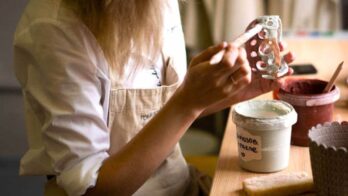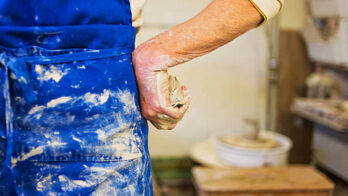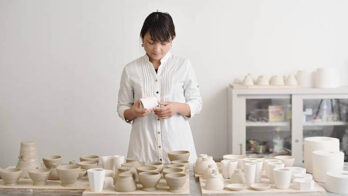Are you looking for a food-safe glaze for your next project? If so, you are in luck! In this blog post, we will discuss low fire glazes and if they are suitable for use on food surfaces. Low fire glazes are easy to apply, making them the perfect choice for any kitchen or dining room project.
What Are Low Fire Glazes?
Low fire glazes are types of glaze that are typically used on ceramics and pottery. Low fire glazes have a lower melting temperature than other types of glazes, making them ideal for use on materials that can’t be fired at high temperatures.
Low fire glazes can be applied to both bisqueware and greenware, and they come in a wide variety of colors and finishes. One of the benefits of low fire glazes is that they are very forgiving, and mistakes can often be easily corrected.
Low fire glazes are a great choice for beginners and experienced ceramicists who want to experiment with new techniques and effects.
Are Low Fire Glazes Food Safe?
When it comes to low fire glazes, there are a lot of different opinions about whether they are safe for food. The main thing to keep in mind is that all glazes, regardless of their firing temperature, have the potential to leach into food. With that said, you can do a few things to minimize the risk.
First, make sure you’re using lead-free and cadmium-free glazes. These are less likely to leach into food than other types of glazes. Second, apply only a thin layer of glaze to your pottery. A thick layer of glaze can increase the risk of leaching. Finally, be sure to follow the manufacturer’s instructions carefully.
If you do all these things, you can feel confident that your low fire glazed pottery is safe for food.
Benefits of Low Fire Glaze
Low fire glaze can be used on a variety of materials, including ceramic, glass, and metal. In addition, low fire glaze is available in a wide range of colors and finishes. Some of the benefits of low fire glaze include the following:
Less Likely to Crack or Break
When it comes to glazes, low fire glazes are the superior option. Low fire glazes are less likely to crack or break than other glazes. This is because they are made with a lower firing temperature. Low fire glazes also tend to be more durable and chip resistant.
Range of Material Usage
Low fire glaze is a type of paint that can be applied to a wide range of materials, including metal, glass, and ceramic. Unlike high fire glaze, which requires high temperatures to cure, low fire glaze can be cured at lower temperatures. This makes it ideal for use on materials that cannot withstand high temperatures.
Variety of Colors
Low fire glazes are available in various colors, from bright shades such as orange and red to deep hues including blue and purple. You can also find low fire glazes in various finishes, including glossy, matte, and textured.
Whether you’re looking to add a pop of color to your dishes or create a more subdued look, you’re sure to find the perfect low fire glaze for your needs. And because low fire glazes are so easy to apply, you can experiment with different colors and finishes until you find the perfect combination for your project.
So, if you are looking for a durable, versatile, and easy-to-use type of glaze, low fire glaze is a perfect choice!
How to Test if a Low Fire Glaze is Food Safe
It is always important to test glazes for food safety, even when they are low fire. The FDA has specific requirements that must be met for a glaze to be considered food safe.
Testing Glazes for Low Fire Applications


- The glaze must be non-toxic.
- It must not absorb more than 5% of its own weight in water.
- It must not leach out more than 5 parts per million of lead when placed in acidic food.
- It must not leach out more than 10 parts per million of cadmium when placed in acidic food.
To test for these specifications, first, mix up a small batch of the glaze according to the recipe. Next, apply the glaze to tiles or bisque porcelain disks and fire to the recommended temperature range. Finally, allow the glazes to cool completely.
Set up a control by marking one tile with a “C” for control and leaving it unglazed. Label the other tiles with the names of the different tests you will be doing. Soak each tile in distilled water for 24 hours, then dry thoroughly and weigh each tile. Compare the weights of the tiles to see if the glaze is absorbent.
Leach lead and cadmium by placing each tile in a separate container of 100 grams of apple cider vinegar. Allow the tiles to soak for 24 hours, then remove and dry them thoroughly. Repeat this process three times.
What to Do if a Low Fire Glaze is Not Food Safe
Undoubtedly, one of the most frustrating moments for a potter is when a beautiful glaze firing does not turn out as planned. Even more frustrating is when the cause of the problem is not immediately obvious.
A low fire glaze that is not food safe is one such issue. While there are a few possible causes, the most likely culprit is an insufficient firing temperature. Low fire glazes need to be fired between 1800- and 1900-degrees Fahrenheit to achieve their desired properties.
If the glaze is not fired hot enough, it will be porous and absorbent, which can lead to harmful chemicals leaching into food. If you find yourself in this situation, the best course of action is to re-fire the piece at the correct temperature.
This may not always be possible, so another solution is to apply a food-safe coating over the glaze. This can provide an effective barrier against leaching, but it will also change the look and feel of the piece. As a result, it should only be used as a last resort.
Conclusion
Low fire glazes are food safe if they are lead-free. However, there can be other harmful chemicals in low fire glazes, so it is important to test the glaze before using it on food surfaces.



Enter your email below to get our FREE beginner friendly tips.
By entering your email address you agree to receive emails from Potters Passion. We'll respect your privacy and you can unsubscribe at any time.



